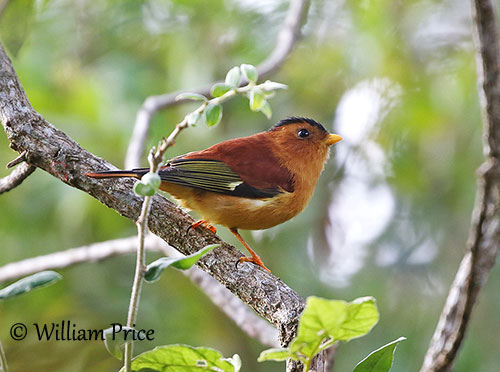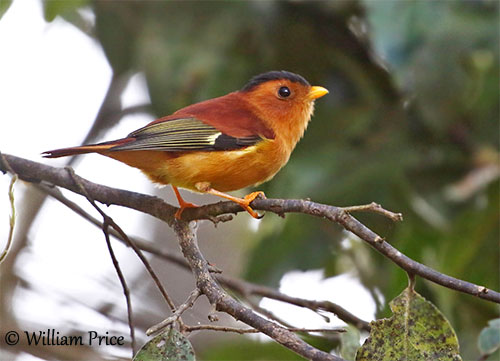
Fr: Piprite chaperonné
Ang: Black-capped Piprites
All: Zimtpipratyrann
Esp: Piprites Capirotado - Bailarín Castaño
Ita: Piprite capinero
Nd: Zwartkapmanakin
Sd: svartkronad piprit
Photographers:
William Price
PBase-tereksandpiper & Flickr William Price
Dubi Shapiro
Dubi Shapiro Photo Galleries
Text by Nicole Bouglouan
Sources:
HANDBOOK OF THE BIRDS OF THE WORLD Vol 9 - by Josep del Hoyo - Andrew Elliot - David Christie - Lynx Edicions - ISBN: 8487334695
BIRDS OF SOUTH AMERICA – Passerines - by Robert S. Ridgely and Guy Tudor – HELM Field Guides – ISBN: 9781408113424
The Black-capped Piprites (Piprites pileata) builds a spherical moss nest
EL BAILARÍN CASTAÑO (Piprites pileata) ESTÁ EN LA RESERVA NATURAL CULTURAL PAPEL MISIONERO, PROVINCIA DE MISIONES, ARGENTINA
Distribución, hábitat, y historia natural del Bailarín Castaño Piprites pileata, una especie Críticamente Amenazada en Argentina
Situación del Bailarín Castaño en la Argentina
Wikipedia, la enciclopedia libre
Black-capped Piprites
Piprites pileata
Passeriformes Order – Tyrannidae Family
INTRODUCTION:
The Black-capped Piprites is one of the three species of genus Piprites in the family Tyrannidae. It was formerly included in the family Pipridae and considered a manakin. However, following genetic analysis, the taxonomic affinities of the genus Piprites are still debated and it seems certain that they are not true manakins.
The nests of two Piprites species have been described through observations in the wild, and they are utterly unlike the manakin’s nests.
The Black-capped Piprites is endemic to the Atlantic Forest of SE Brazil and the Province of Misiones in NE Argentina.
This is an arboreal species often found in forest subcanopy where it forages, feeding on small fruits and arthropods.
From observations, the nest is spherical with side entrance, placed about 8 metres above the ground in tree fork.
The Black-capped Piprites is affected by habitat loss through deforestation, logging, fires and clearing for agriculture. The species is currently listed as Near Threatened.

DESCRIPTION OF THE BIRD:
Biometrics:
Length: 12 cm
Weight: (1 male): 15g
The Black-capped Piprites adult male has black crown and nape, giving the bird its English name.
The upperparts are bright chestnut. On the upperwing, the flight-feathers are blackish with conspicuous yellowish-green edges and prominent whitish primary bases. The tail is rufous with black central rectrices.
On the underparts, the breast is cinnamon-rufous, becoming paler and mostly yellow on the lower underparts.
On the head, the area from crown to nape is black. Lower forehead and face are cinnamon-rufous, but chin and throat are slightly paler.
The bill is yellow. The eyes are dark brown. Legs and feet are orange-yellow.
The female (not displayed) resembles male but she is duller above, with olive back. The upperwing-coverts are dusky with pale greyish tips, forming indistinct pale wingbars.
The juvenile is not described.
RANGE:
The Black-capped Piprites is found locally from SE Brazil (S Minas Gerais and Río de Janeiro, S to N Río Grande do Sul), and in the province of Misiones in NE Argentina.
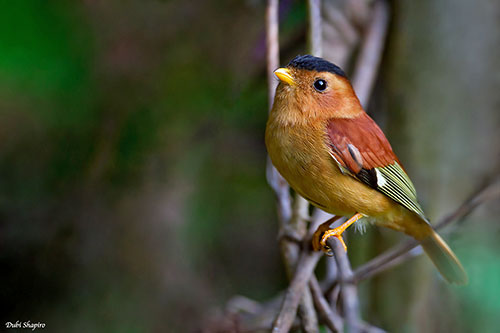
HABITAT:
The Black-capped Piprites is rare in subcanopy and borders of montane forest and woodland which are its natural habitat.
However, it frequents the Montane Atlantic Forest in the southern part of the range, especially where conifers of the species Araucaria angustifolia are present.
The species is visible between 500 and 2,000 metres of elevation.
CALLS AND SONGS: SOUNDS BY XENO-CANTO
The Black-capped Piprites male gives a distinctive but disjointed and patternless, fast “chik, chik, cheeur, chee-unh” usually variable but always with the same chortling quality. The female utters a repeated “cheenh” of similar quality.
The calls include a single “wheeu” followed by several shorter, less loud notes.
BEHAVIOUR IN THE WILD:
The Black-capped Piprites feeds primarily on small fruits, supplemented by small insects. The fruit is plucked from branches in a rapid aerial sally from a nearby perch. Then, the bird lands with the food in the bill and swallows it whole.
Arthropods are snatched from foliage following a short flight.
The Black-capped Piprites forages in canopy and subcanopy, although it is also found in dense understorey of bamboo thickets. It may sometimes accompany mixed-species foraging flocks.
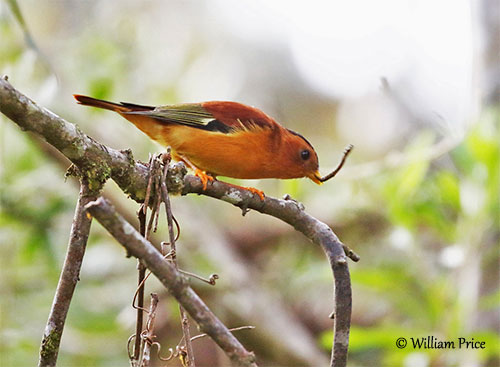
During the breeding season, and especially while the female is building the globular nest, the male performs courtship displays. It accompanies the female during the nest building but it does not take part in the work.
The male constantly fans both wings and tail. The bill is closed and the body in normal position. When the female enters the nest, the male flies to a close branch from which it performs a short, circular, vertical flight in front of the nest, before returning to the perch.
The Black-capped Piprites has a very beautiful plumage, probably well-exposed and enhanced during the displays.
The nest is built by the female alone.
The Black-capped Piprites is apparently resident, with probably some altitudinal movements.
The flight is fast and agile, especially during the displays. The Spanish name of this species “Bailarín Castaño” (Brown Dancer), can give an idea of the graceful movements performed by the bird during the displays.
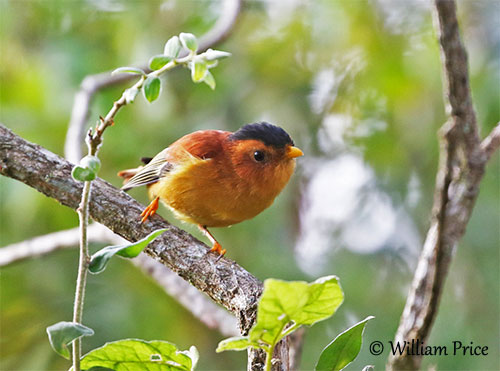
REPRODUCTION OF THIS SPECIES:
The breeding season takes place in September, October and November, following observations of displays and nest building.
An observation in the Province of Misiones in NE Argentina in 2006, allowed to describe the nest of the Black-capped Piprites. The nest-site was at the western edge of the Yabotí Biosphere Reserve in the Atlantic Forest, a mixed laurel and conifer forest.
The nest is described as a loosely constructed sphere, built about 8 metres above the ground in tree fork in laurel Ocotea pulchella. It was 15 cm tall, 14 cm wide and 13 cm deep. The side entrance measured 4 cm tall and 3 cm wide.
This spherical structure was made with moss (Neckeropsis undulata and Orthostichella versicolor), and a few tiny roots. The interior was lined with strands of Marasmius spifungus. This material is often used by numerous bird species in the Atlantic Forest.
The nest was 200 metres from a stream, and the forest was 15-20 metres high. It was built by the female while the male was displaying on the nearby branches.
No more information.
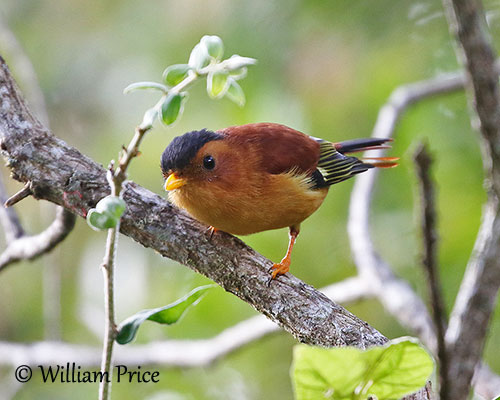
PROTECTION / THREATS / STATUS:
The Black-capped Piprites has restricted range in which it is rare, local, and sparsely distributed.
It is affected by habitat loss caused by deforestation, especially in lowland forests. The Araucaria forests have been much restricted in extent. Clearing for ecotourism and agriculture, logging and fires lead to habitat degradation.
However, the species occurs in several protected areas and National Parks.
The population is roughly estimated at 2,800/22,400 mature individuals, and it is declining.
The Black-capped Piprites is currently classified as Near Threatened.
